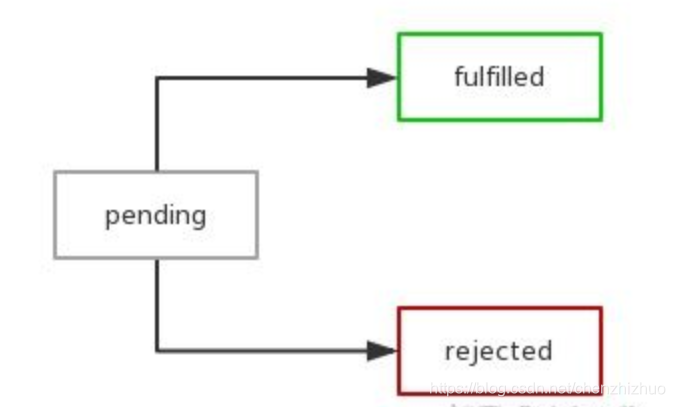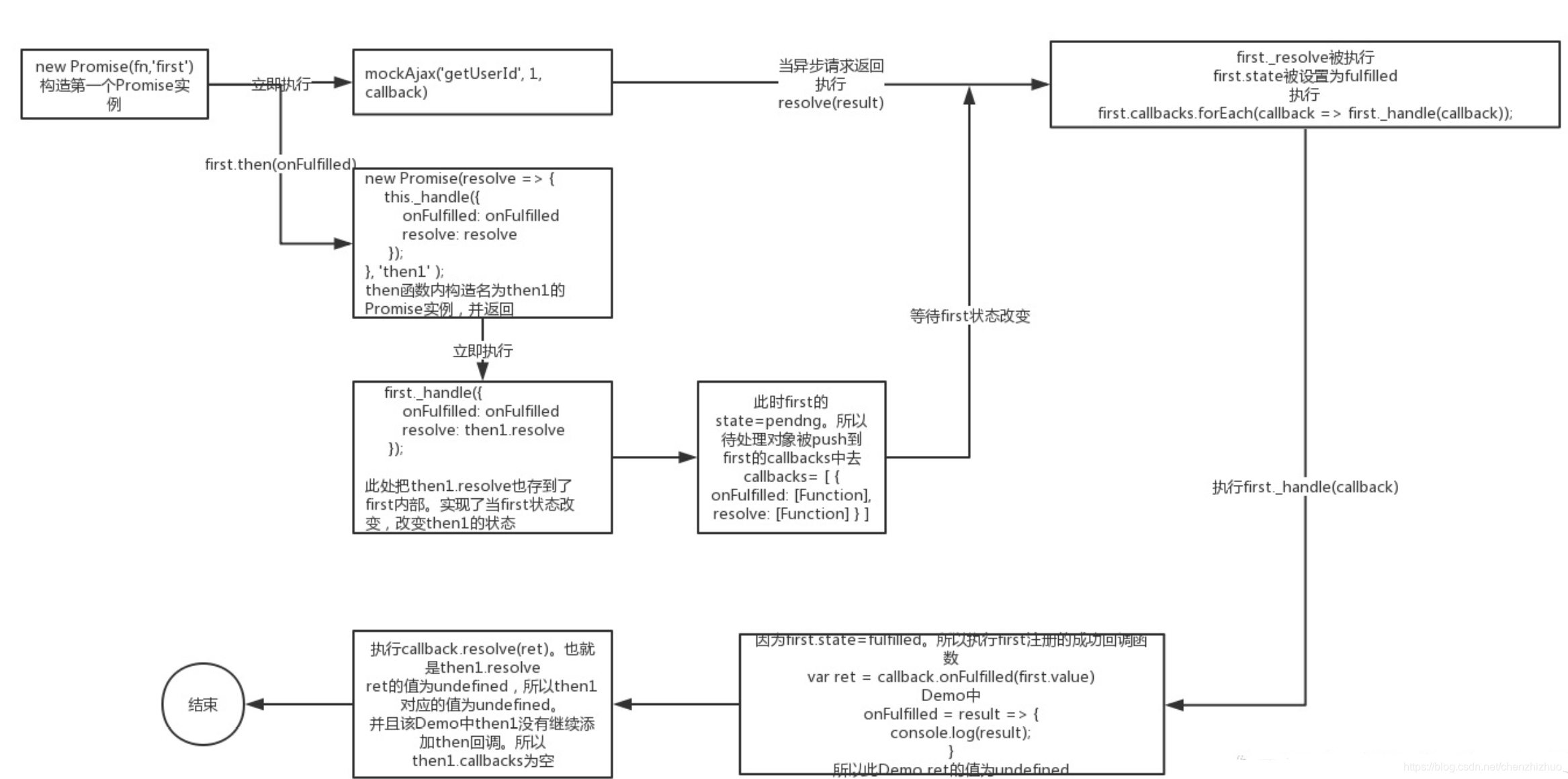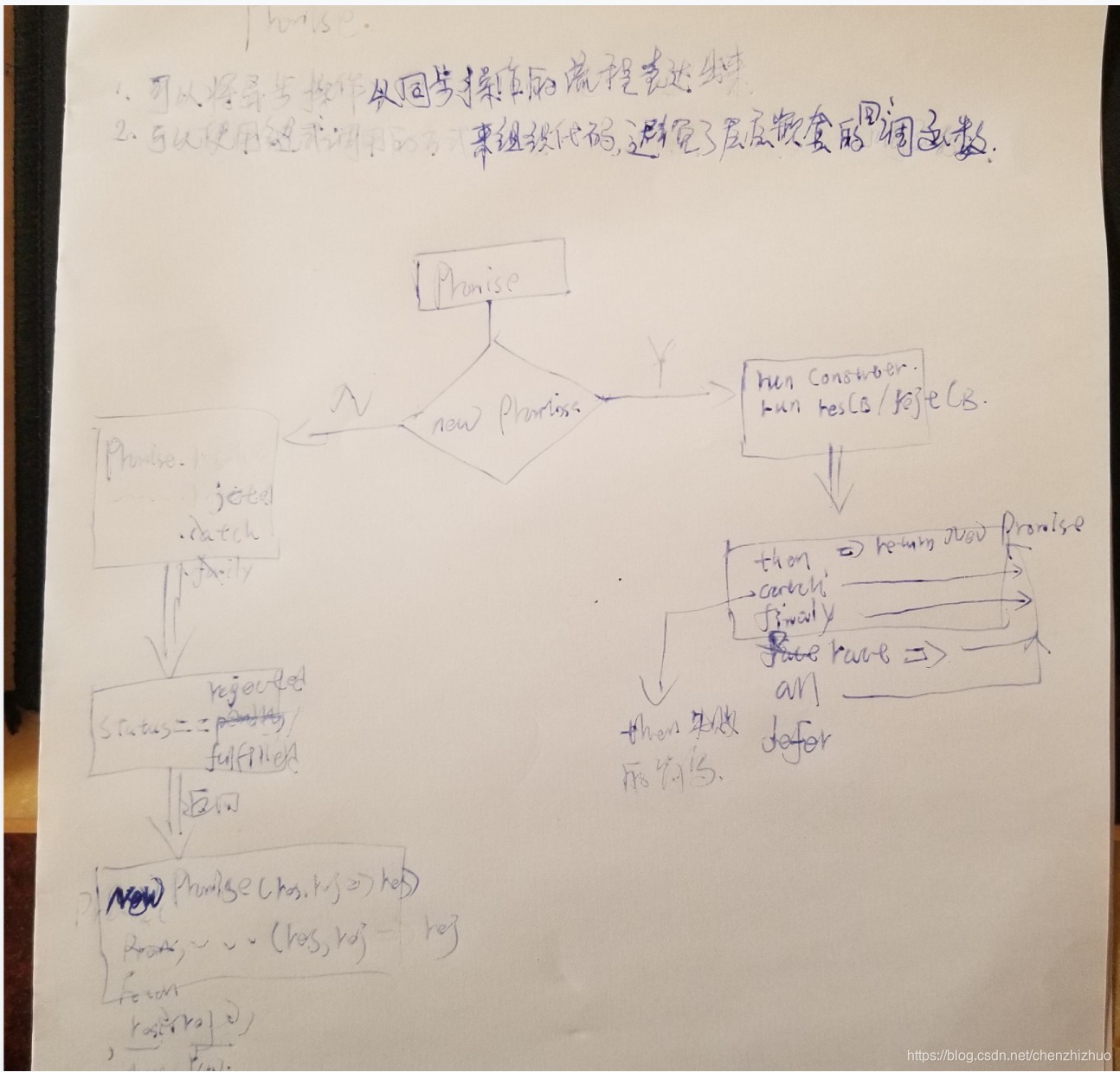前言
Promise 前端开发或多或少都有了解或使用到。 抽空梳理了一下,阅读本章希望能帮助了解Promise到底是怎么实现的。 我们采用渐进法,通过Demo 逐步实现Promise来体会Promise的用法。
Promise 规范有很多, 如 Promise/A, Promise/B, Promise/D == 以及 Promise/A 的升级 Promise/A+ , 有兴趣可以去了解下。 最终ES6中采用了 Promise/A+ 规范。 所以本篇文章是按照Promise/A+== 规范来编写的。(不想看英文版的转至 Promise/A+ 规范
中文翻译)
Promise概要图
先来抛个砖
我们从一个场景开始讲解。 考虑下面demo 获取用户账号的请求处理:
//不使用Promise
ajax.get('some_url', function (result) {
//do something
console.log(result.accountNumber );
});
//使用Promise
new Promise(function (resolve) {
//异步请求
ajax.get('some_url', function (results) {
resolve(results.accountNumber )
})
}).then(function (accountNumber ) {
//do something
console.log(accountNumber );
})
看起来好像不适用Promise 更简洁下。 非也! 设想一下, 如果好几个依赖前置请求都是异步, 此时如果没有Promise , 那回调函数要一层一层嵌套, 看起来就很不舒服了。
如下:
//不使用Promise
ajax.get('some_url', function (accountNumber ) {
//do something
ajax.get('getId', id, function (name) {
//do something
ajax.get('getName', name, function (course) {
//dong something
ajax.get('getCourse', function (courseDetail) {
//do something
})
})
})
});
//使用Promise
function getAccountNumber (url) {
return new Promise(function (resolve) {
//异步请求
ajax.get(url, function (accountNumber ) {
resolve(accountNumber )
})
})
}
getUserId('some_url').then(function (accountNumber ) {
//do something
return getId(accountNumber );
}).then(function (name) {
//do something
return getName(name);
}).then(function (course) {
//do something
return getCourse(course);
}).then(function (courseDetail) {
//do something
});
来引个玉 (实现原理渐进)
说到底, Promise 也还是使用回调函数, 只不过是把回调封装在了内部, 我们使用上一直通过then方法的链式调用, 书写和理解上会更加直观和简洁。
1. 简单的实现
//简单的实现
class Promise {
callbacks = [];
constructor(fn) {
fn(this._resolve.bind(this));
}
then(onFulfilled) {
this.callbacks.push(onFulfilled);
}
_resolve(value) {
this.callbacks.forEach(fn => fn(value));
}
}
//Promise应用
let p = new Promise(resolve => {
setTimeout(() => {
console.log('done');
resolve('6秒');
}, 6000);
}).then((tip) => {
console.log(tip);
})
这个简单版本大致逻辑是:
实例化Promise 时,其类构造函数初始化执行了回调函数,并将绑定了当前实例的==_resolve方法作为参数回传给回到函数。接着调动Promise对象的then方法, 注册异步操作完成后的回调函数。 当异步操作完成时,调用resolve方法, 该方法执行then==方法注册的回调函数。
这里then 方法注册完成时的回到是一个数组, so then方法可以多次调用。注册的函数会在异步操作完成后根据添加的顺序依次执行。
如下:
//then 的说明
let p = new Promise(resolve => {
setTimeout(() => {
console.log('done');
resolve('6秒');
}, 6000);
});
p.then(tip => {
console.log('then1', tip);
});
p.then(tip => {
console.log('then2', tip);
});
仔细的同学可以看出, then方法应该是链式调用。 上面的调用方式就显得有点啰嗦了。 我们来修改下我们的简单实现源码, 即在then 中 return this 就OK了。
实例:
//极简的实现+链式调用
class Promise {
callbacks = [];
constructor(fn) {
fn(this._resolve.bind(this));
}
then(onFulfilled) {
this.callbacks.push(onFulfilled);
return this;//看这里
}
_resolve(value) {
this.callbacks.forEach(fn => fn(value));
}
}
let p = new Promise(resolve => {
setTimeout(() => {
console.log('done');
resolve('6秒');
}, 6000);
}).then(tip => {
console.log('then1', tip);
}).then(tip => {
console.log('then2', tip);
});
2. 加入延时机制
问题来了, 上面的Promise 实现如果在then方法注册回调函数之间,resolve就执行了, 肿么办? 这样回调函数就不会执行到了。 比如我们把上栗中setTimeout去掉:
//同步执行了resolve
let p = new Promise(resolve => {
console.log('同步执行');
resolve('同步执行');
}).then(tip => {
console.log('then1', tip);
}).then(tip => {
console.log('then2', tip);
});
执行结果只打印显示了 “同步执行”。 再回去看下Promise的源码, 发现resolve执行时, callbacks 还是空数组, 回调函数还没来得急注册上去。
这显然是不允许的。 Promises/A++规范明确要求回调需要通过异步方式执行, 用以保证一致可靠的执行顺序。 那我们加入一些处理,保证在resolve执行之前,then方法已经注册完所有回调。 在来改造下我们resolve函数:
//极简的实现+链式调用+延迟机制
class Promise {
callbacks = [];
constructor(fn) {
fn(this._resolve.bind(this));
}
then(onFulfilled) {
this.callbacks.push(onFulfilled);
return this;
}
_resolve(value) {
setTimeout(() => {//看这里
this.callbacks.forEach(fn => fn(value));
});
}
}
在resove 中增加定时器, 通过定时器,将resolve 中执行的回调函数放置到JS任务队列末尾, 以保证在resolve执行时, then方法的回调函数已经注册完成。
当然这样依然存在一个问题, 在resolve 执行后, 在通过 then 注册上来的回调好像都没有机会执行了!!!! 如下示例: 加上延迟后 then1 , then2 可以打印出来, 但是 then3 依然不OK。
let p = new Promise(resolve => {
console.log('同步执行');
resolve('同步执行');
}).then(tip => {
console.log('then1', tip);
}).then(tip => {
console.log('then2', tip);
});
setTimeout(() => {
p.then(tip => {
console.log('then3', tip);
})
});
所以接下来我们需要增加一个状态,并且保存 resolve 的值。 go on~
3. 加入状态
为了解决上面提到的问题, 我们需要加入状态机制, 也就是大家熟知的pending, fulfilled, rejected。
Promises/A+ 规范中明确规定了, pending 可以转化为fulfilled 或 rejected 并且只能转化一次。 也就是说如果pending 转为 fulfiled 就不能再转化到rejected。 并且 fulfilled 和 rejected 状态只能pending转化而来, 两者之间不能互相转换。

增加状态后的代码为:
//简单的实现+链式调用+延迟机制+状态
class Promise {
callbacks = [];
state = 'pending';//增加状态
value = null;//保存结果
constructor(fn) {
fn(this._resolve.bind(this));
}
then(onFulfilled) {
if (this.state === 'pending') {//在resolve之前,跟之前逻辑一样,添加到callbacks中
this.callbacks.push(onFulfilled);
} else {//在resolve之后,直接执行回调,返回结果了
onFulfilled(this.value);
}
return this;
}
_resolve(value) {
this.state = 'fulfilled';//改变状态
this.value = value;//保存结果
this.callbacks.forEach(fn => fn(value));
}
}
resolve 执行时, 会将状态设置为 fulfilled , 并把 value 的值存起来, 在此之后调用 then 添加的新回调都会立即执行, 直接返回保存的value值。
注: 当增加完状态之后, 原先的_resolve中的定时器可以去掉了。 当resolve 同步执行, 虽然callbacks 为空, 回调函数还没来得及注册, 但没关系, 因为后面注册上来时, 判断状态为 fulfilled后, 会立即遍历执行回调。
4. 真正的链式调用
有个非非非常重要的问题, 优秀的你应该发现了, 上面提到的链式调用,只是在then方法中 **return 了 this **, 使得 Promise 实例可以多次调用 then方法,但因为是同一个实例, 调用再多次then也只能返回相同的一个结果。 SO , 这里满足不了我们真正的使用需求。
真正的链式Promise 是指在当前Promise 达到 fulfilled 状态后, 即开始进行下一个Promise (后邻Promise)。 那么我们如何衔接当前Promise 和后邻Promise呢? 这里是重点!!!
先来看下完整的实现源码:
//完整的实现
class Promise {
callbacks = [];
state = 'pending';//增加状态
value = null;//保存结果
constructor(fn) {
fn(this._resolve.bind(this));
}
then(onFulfilled) {
return new Promise(resolve => {
this._handle({
onFulfilled: onFulfilled || null,
resolve: resolve
});
});
}
_handle(callback) {
if (this.state === 'pending') {
this.callbacks.push(callback);
return;
}
//如果then中没有传递任何东西
if (!callback.onFulfilled) {
callback.resolve(this.value);
return;
}
var ret = callback.onFulfilled(this.value);
callback.resolve(ret);
}
_resolve(value) {
if (value && (typeof value === 'object' || typeof value === 'function')) {
var then = value.then;
if (typeof then === 'function') {
then.call(value, this._resolve.bind(this));
return;
}
}
this.state = 'fulfilled';//改变状态
this.value = value;//保存结果
this.callbacks.forEach(callback => this._handle(callback));
}
}
先来 简单说说要点,然后在逐一通过例子去详解。
- then 方法中, 创建返回了新的Promise 实例, 这是串行Promise的基础, 是实现真正链式调用的根本。
- handle 方法是Promise 内部的方法。 then 方法传入的形参onFulfilled以及新创建Promise 实例时传入的resolve匀被 push 到当前 Promise 的callbacks
队列中, 这是衔接当前 promise 和 后邻 promise 的关键。 - resolve 方法中会先检查value 是不是 Promise 对象, 如果是一个新的 Promise , 那么先不改变当前 promise 的状态。
来一个栗子(这里直贴主要代码片段,能理解即可):
/**
* 模拟异步请求
* @param {*} url 请求的URL
* @param {*} s 指定该请求的耗时,即多久之后请求会返回。单位秒
* @param {*} callback 请求返回后的回调函数
*/
const mockAjax = (url, s, callback) => {
setTimeout(() => {
callback(url + '异步请求耗时' + s + '秒');
}, 1000 * s)
}
//Demo1
new Promise(resolve => {
mockAjax('getId', 1, function (result) {
resolve(result);
})
}, 'first').then(result => {
console.log(result);
});
为了清楚的看到当前是哪个实例, 在Promise 的实现中, 增加了一个 name 属性, 标识当前 Promise 实例, 上栗中传了‘first’表示第一个Promise实例。
下面为输入日志:
Promise[first]:constructor
Promise[first]:then
Promise[then1]:constructor
Promise[first]:_handle state= pending
Promise[first]:_handle callbacks= [ { onFulfilled: [Function], resolve: [Function] } ]
=> Promise { callbacks: [], name: 'then1', state: 'pending', value: null }
Promise[first]:_resolve
Promise[first]:_resolve value= getUserId异步请求耗时1秒
Promise[first]:_handle state= fulfilled
getUserId异步请求耗时1秒
Promise[then1]:_resolve
Promise[then1]:_resolve value= undefined
通过上面打印日志可以看到:
- 构造first实例,立即执行mackAjax(‘getUserId’,callback);
- 调用first的then方法,注册first完成时的回调函数。
- then函数内部构造了一个新的Promise实例:then1。立即执行first的_handle方法
- 此时first还是pending的状态
- first._handle中就把注册在first成功后的回调和then1的状态改变操作接口保存在first内 部
- 至此当前线程执行结束。返回的是then1的Promise实例。
- 1s后,异步请求返回,要改变first的状态和结果,执行resolve(result)
- first的值被改变,内容为异步请求返回的结果:“getUserId异步请求耗时1s”
- first的状态变成fulfilled
- first注册的成功回调被执行,打印出了"getUserId异步请求耗时1秒"
- 然后再调用then1._resolve
- 改变then1的值和状态,因为first注册的回调函数没有返回值,所以then1的值为undefined
这里补一张直观的流程图

如果我们吧上面异步的请求改成同步会是什么结果呢?
new Promise(resolve => {
resolve('getUserId同步请求');
}, 'first').then(result => {
console.log(result);
});
//打印日志
Promise[first]:constructor
Promise[first]:_resolve
Promise[first]:_resolve value= getUserId同步请求
Promise[first]:then
Promise[then1]:constructor
Promise[first]:_handle state= fulfilled
getUserId同步请求
Promise[then1]:_resolve
Promise[then1]:_resolve value= undefined
=> Promise {
callbacks: [],
name: 'then1',
state: 'fulfilled',
value: undefined }
感兴趣的可以自己去分析一下。
至此, 应该基本能够理解真正的链式调用了吧。 如果是多个then 时,要知道它是可以无限写下去的, 上一级 onFulfilled return 的值, 会变成下一级onFulfilled的结果
那么接下来我们对比下下面的两个Demo:
Demo2
//Demo2
new Promise(resolve => {
mockAjax('getUserId', 1, function (result) {
resolve(result);
})
}, 'first').then(result => {
console.log(result);
//对result进行第一层加工
let exResult = '前缀:' + result;
return exResult;
}).then(exResult => {
console.log(exResult);
let xxResult = exResult + ':后缀';
return xxResult;
}).then(finalResult => {
console.log(finalResult);
});
Demo3
//Demo3 === Demo2
new Promise(resolve => {
mockAjax('getUserId', 1, function (result) {
resolve(result);
})
}, 'first').then(result => {
console.log(result);
//对result进行第一层加工
let exResult = '前缀:' + result;
console.log(exResult);
let finalResult = exResult + ':后缀';
console.log(finalResult);
});
感觉demo3 的写法更好些!!! 那链式调用的意义在哪里?
仔细的同学一定发现了, 目前为止Promise 源码中还有一块代码没有被执行到。 也就是下面 _resolve 中最开始的 if 代码块, 好像从来没有被执行到。
_resolve(value) {
if (value && (typeof value === 'object' || typeof value === 'function')) {
var then = value.then;
if (typeof then === 'function') {
then.call(value, this._resolve.bind(this));
return;
}
}
this.state = 'fulfilled';//改变状态
this.value = value;//保存结果
this.callbacks.forEach(callback => this._handle(callback));
}
从代码上看, 它是对resolve 中的值做了一个特殊的判断, 判断resolve的值是否为Promise 实例, 如果是Promise 实例, 那么就把当前Promise实例的改变状态的接口重新注册到resolve的值Promise 的成功回调中, 也就是说当前 Promise 实例的状态要依赖resolve的值的Promise实例的状态。
//Demo4
const getId = function () {
new Promise(resolve => {
mockAjax('getId', 1, function (result) {
resolve(result);
})
}, 'getUserId');
}
const getId = function () {
new Promise(resolve => {
mockAjax('getId', 2, function (result) {
resolve(result);
})
}, 'getId');
}
const getName = function () {
new Promise(resolve => {
mockAjax('getName', 3, function (result) {
resolve(result);
})
}, 'getName');
}
const getCourse = function () {
new Promise(resolve => {
mockAjax('getCourse', 4, function (result) {
resolve(result);
})
}, 'getCourse');
}
getId()
.then(id => {
console.log(id);
return geId();
}).then(name => {
console.log(name);
return getName()
}).then(course => {
console.log(course);
return getCourse()
}).then(courseDetail => {
console.log(courseDetail);
});
运行结果如下:
Promise[getId]:constructor
Promise[getId]:then
Promise[then1]:constructor
Promise[getId]:_handle state= pending
Promise[getId]:_handle callbacks= [ { onFulfilled: [Function], resolve: [Function] } ]
Promise[then1]:then
Promise[then2]:constructor
Promise[then1]:_handle state= pending
Promise[then1]:_handle callbacks= [ { onFulfilled: [Function], resolve: [Function] } ]
Promise[then2]:then
Promise[then3]:constructor
Promise[then2]:_handle state= pending
Promise[then2]:_handle callbacks= [ { onFulfilled: [Function], resolve: [Function] } ]
Promise[then3]:then
Promise[then4]:constructor
Promise[then3]:_handle state= pending
Promise[then3]:_handle callbacks= [ { onFulfilled: [Function], resolve: [Function] } ]
=> Promise { callbacks: [], name: 'then4', state: 'pending', value: null }
Promise[getId]:_resolve
Promise[getId]:_resolve value= getId异步请求耗时1秒
Promise[getId]:_handle state= fulfilled
getId异步请求耗时1秒
Promise[getId]:constructor
Promise[then1]:_resolve
Promise[then1]:_resolve value= Promise {
callbacks: [],
name: 'getId',
state: 'pending',
value: null }
Promise[getId]:then
Promise[then5]:constructor
Promise[getId]:_handle state= pending
Promise[getId]:_handle callbacks= [ { onFulfilled: [Function], resolve: [Function] } ]
Promise[getId]:_resolve
Promise[getId]:_resolve value= getId异步请求耗时2秒
Promise[getId]:_handle state= fulfilled
Promise[then1]:_resolve
Promise[then1]:_resolve value= getId异步请求耗时2秒
Promise[then1]:_handle state= fulfilled
getId异步请求耗时2秒
Promise[getName]:constructor
Promise[then2]:_resolve
Promise[then2]:_resolve value= Promise {
callbacks: [],
name: 'getName',
state: 'pending',
value: null }
Promise[getName]:then
Promise[then6]:constructor
Promise[getName]:_handle state= pending
Promise[getName]:_handle callbacks= [ { onFulfilled: [Function], resolve: [Function] } ]
Promise[then5]:_resolve
Promise[then5]:_resolve value= undefined
Promise[getName]:_resolve
Promise[getName]:_resolve value= getName异步请求耗时3秒
Promise[getName]:_handle state= fulfilled
Promise[then2]:_resolve
Promise[then2]:_resolve value= getName异步请求耗时3秒
Promise[then2]:_handle state= fulfilled
getName异步请求耗时3秒
Promise[getCourse]:constructor
Promise[then3]:_resolve
Promise[then3]:_resolve value= Promise {
callbacks: [],
name: 'getCourse',
state: 'pending',
value: null }
Promise[getCourse]:then
Promise[then7]:constructor
Promise[getCourse]:_handle state= pending
Promise[getCourse]:_handle callbacks= [ { onFulfilled: [Function], resolve: [Function] } ]
Promise[then6]:_resolve
Promise[then6]:_resolve value= undefined
Promise[getCourse]:_resolve
Promise[getCourse]:_resolve value= getCourse异步请求耗时4秒
Promise[getCourse]:_handle state= fulfilled
Promise[then3]:_resolve
Promise[then3]:_resolve value= getCourse异步请求耗时4秒
Promise[then3]:_handle state= fulfilled
getCourse异步请求耗时4秒
Promise[then4]:_resolve
Promise[then4]:_resolve value= undefined
Promise[then7]:_resolve
Promise[then7]:_resolve value= undefined
错误处理
在异常操作失败时,标记其状态为rejected , 并执行注册的失败回调。
//demo reject
new Promise((resolve, reject) => {
mockAjax('getId', 1, function (result, error) {
if (error) {
reject(error)
} else {
resolve(result);
}
})
}, 'getId').then(result => {
console.log(result);
}, error => {
console.log(error);
});
有了之前处理fulfilled 状态的经验, 支持错误处理就变的很容易了, 只需要在注册回调, 处理状态变更上都加入新的 reject 逻辑:
//完整的实现+reject
class Promise {
callbacks = [];
state = 'pending';//增加状态
value = null;//保存结果
constructor(fn) {
fn(this._resolve.bind(this), this._reject.bind(this));
}
then(onFulfilled, onRejected) {
return new Promise((resolve, reject) => {
this._handle({
onFulfilled: onFulfilled || null,
onRejected: onRejected || null,
resolve: resolve,
reject: reject
});
});
}
_handle(callback) {
if (this.state === 'pending') {
this.callbacks.push(callback);
return;
}
let cb = this.state === 'fulfilled' ? callback.onFulfilled : callback.onRejected;
if (!cb) {//如果then中没有传递任何东西
cb = this.state === 'fulfilled' ? callback.resolve : callback.reject;
cb(this.value);
return;
}
let ret = cb(this.value);
cb = this.state === 'fulfilled' ? callback.resolve : callback.reject;
cb(ret);
}
_resolve(value) {
if (value && (typeof value === 'object' || typeof value === 'function')) {
var then = value.then;
if (typeof then === 'function') {
then.call(value, this._resolve.bind(this), this._reject.bind(this));
return;
}
}
this.state = 'fulfilled';//改变状态
this.value = value;//保存结果
this.callbacks.forEach(callback => this._handle(callback));
}
_reject(error) {
this.state = 'rejected';
this.value = error;
this.callbacks.forEach(callback => this._handle(callback));
}
}
异常处理
上面介绍了错误处理, 是指在Promise 的构造函数中发现的错误, 并通过reject 通知的。 如果在执行成功或者失败回调时出现了异常,该如何处理??
对于类似异常, 处理也很简单, 可以使用try-catch 捕获错误, 然后将相应的promise 状态设置为rejected 状态。 我们来改造下==_handle==方法如下:
_handle(callback) {
if (this.state === 'pending') {
this.callbacks.push(callback);
return;
}
let cb = this.state === 'fulfilled' ? callback.onFulfilled : callback.onRejected;
if (!cb) {//如果then中没有传递任何东西
cb = this.state === 'fulfilled' ? callback.resolve : callback.reject;
cb(this.value);
return;
}
let ret;
try {
ret = cb(this.value);
cb = this.state === 'fulfilled' ? callback.resolve : callback.reject;
} catch (error) {
ret = error;
cb = callback.reject
} finally {
cb(ret);
}
}
无论是错误还是异常, 最终都是通过reject 实现的, 可见最终对于错误以及异常的处理, 都可以通过then中的错误回调来处理。 所以可以单独增加一个catch 方法, 它是 .then(null, rejection) 的别名。
如下:
then(onFulfilled, onRejected) {
return new Promise((resolve, reject) => {
this._handle({
onFulfilled: onFulfilled || null,
onRejected: onRejected || null,
resolve: resolve,
reject: reject
});
});
}
catch(onError){
this.then(null, onError);
}
Finally 方法
这个方法不用多说,想必大家都很熟。 不过Promise最后的状态如何, 都要执行的操作。 finally 的实现其实很简单:
catch(onError) {
console.log('Promise[%s]:catch', this.name);
this.then(null, onError);
}
finally(onDone){
console.log('Promise[%s]:finally', this.name);
this.then(onDone, onDone);
}
静态方法
除了上面提到的Promise 实例的方法外, Promise 还提供了 Promise.resolve 和 Promise.reject 方法。 用于将非Promise实例包装为Promise实例。
Promise.resolve('foo')
// 等价于
new Promise(resolve => resolve('foo'))
这里 静态方法有个特点: 如果其参数为promise 则什么都不做,返回参数; 如果参数为一个非promise 对象, 则创建并返回一个promise 。
再来看看这个例子:
Promise.resolve(getNameById(id)).then(name => {
console.log(name);
});
在实现Promise.resolve 之前, 先看下它的参数部分有哪些情况:
1.参数是一个Promise实例
如果参数是 Promise 实例,那么Promise.resolve将不做任何修改、原封不动地返回这个实例。
2.参数是一个thenable对象
thenable对象指的是具有then方法的对象,比如下面这个对象。
let thenable = {
then: function(onFulfilled) {
onFulfilled(42);
}
};
Promise.resolve方法会将这个对象转为 Promise 对象,然后就立即执行thenable对象的then方法。
let thenable = {
then: function(onFulfilled) {
onFulfilled(42);
}
};
let p1 = Promise.resolve(thenable);
p1.then(function(value) {
console.log(value); // 42
});
上面代码中,thenable对象的then方法执行后,对象p1的状态就变为resolved,从而立即执行最后那个then方法指定的回调函数,输出 42。
3. 参数不是具有then方法的对象,或根本就不是对象
如果参数是一个原始值,或者是一个不具有then方法的对象,则Promise.resolve方法返回一个新的 Promise 对象,状态为resolved。
4. 不带任务参数
Promise.resolve方法允许调用时不带参数,直接返回一个resolved状态的 Promise 对象。
finally(onDone) {
this.then(onDone, onDone);
}
static resolve(value) {
if (value && value instanceof Promise) {
return value;
} else if (value && typeof value === 'object' && typeof value.then === 'function') {
let then = value.then;
return new Promise(resolve => {
then(resolve);
});
} else if (value) {
return new Promise(resolve => resolve(value));
} else {
return new Promise(resolve => resolve());
}
}
Promise.reject与Promise.resolve类似,区别在于Promise.reject始终返回一个状态的rejected的Promise实例,而Promise.resolve的参数如果是一个Promise实例的话,返回的是参数对应的Promise实例,所以状态不一 定。
Promise.resolve / Promise.reject/ Promise.catch 内部实现
// 使用
Promise.resolve('is resolve').then(data=>{
console.log(data) // is resolve
})
// 内部实现
Promise.resolve = function(value) {
return new Promise((resolve, reject) => { // 内部new一个Promise对象
resolve(value)
})
}
// reject 内部实现
Promise.reject = function(resason) {
return new Promise((resolve, reject) => {
reject(reason)
})
}
// catch 内部实现
Promise.reject('is reject').catch(e => {
console.log(e) // is reject
})
// 上面这段代码相当于下面这段代码
Promise.reject('is reject').then(null, e =>{ // then里直接走了失败的回调
console.log(e) // is reject
})
// 内部实现
Promise.prototype.catch = function(onReected) {
return this.then(null, onRejected) // 相当与then里的成功回调只传个null
}
** Promise.all 内部实现**
// Promise.all 这个方法非常重要, 同时执行多个异步,并返回一个新的promise, 成功的值是一个数组, 该数组成员的顺序是传给Promise.all的顺序
// Promise.all 的使用
function usePromise(url, params){
return new Promise((resolve, reject) => {
setTimeout(function(err, data){
if(err) reject(err)
resolve(data)
}, 2000)
})
}
Promise.all(usePromise('url1',{}), usePromise(url2, {})).then(data => {
console.log(data) // 全部读取成功后返回[data1, data2, ....]
// 需要注意的是,其中有一个失败,则走失败的回调函数
})
// 内部实现
Promise.all = function(promises) { // promises 是个数组
let arr = [];
let i = 0;
function processData(index, data) {
arr[index] = data
if(++i == promises.length){
resolve(arr)
}
}
for(let i = 0; i<promise.length; i++) {
promsies[i].then(data => {
// 因为Promise.all 最终返回的是一个数组成员按照顺序排序的数组,
// 而异步执行,返回并不一定按照顺序, 所以需要传当前的i
processData(i, data);
}, reject) // 如果其中一个失败,则调用reject
}
}
Promise.race 内部实现
// 原生Promise.race的使用
// 一个成功就走成功的回调,一个失败就走失败的回调
Promise.race(promise1, promise2,...).then(data => {
console.log(data); // 可能返回promise1的结果, 也可能返回promise2的结果,看哪个返回的快就用哪个作为结果
})
// 内部实现
Promise.race = function(promises) { // promises 是数组
return new Promise((resolve, reject) => {
for(let i=0; i<promise.length; i++) {
promises[i].then(resolve, reject) //
}
})
}
总结
刚开始看promise源码的时候总不能很好的理解then和resolve函数的运行机理,但是如果反过来根据执行promise时的逻辑来推演,就不难理解了。这里一定要注意的点是:promise里面的then函数仅仅是注册了后续需要执行的代码,真正的执行是在resolve方法里面执行的,理清了这层,再来分析源码会省力的多。
现在回顾下Promise的实现过程,其主要使用了设计模式中的观察者模式:
通过Promise.prototype.then和Promise.prototype.catch方法将观察者方法注册到被观察者Promise对象中,同时返回一个新的Promise对象,以便可以链式调用。
被观察者管理内部pending、fulfilled和rejected的状态转变,同时通过构造函数中传递的resolve和reject方法以主动触发状态转变和通知观察者。







 本文通过逐步实现Promise,深入探讨Promise的工作原理及其核心特性。从简单的封装到实现完整的Promise/A+规范,包括状态管理、链式调用、错误处理等功能。
本文通过逐步实现Promise,深入探讨Promise的工作原理及其核心特性。从简单的封装到实现完整的Promise/A+规范,包括状态管理、链式调用、错误处理等功能。

















 2万+
2万+

 被折叠的 条评论
为什么被折叠?
被折叠的 条评论
为什么被折叠?








